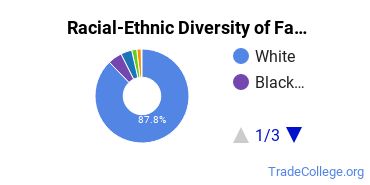Fairmont State University Trade Programs
Fairmont State University is a public institution located in Fairmont, West Virginia. Fairmont is a good match for students who enjoy small-town life.
Featured schools near , edit
Where Is Fairmont State University?

Contact details for Fairmont State are given below.
| Contact Details | |
|---|---|
| Address: | 1201 Locust Ave, Fairmont, WV 26554-2470 |
| Phone: | 304-367-4000 |
| Website: | www.fairmontstate.edu |
Can I Afford Fairmont State?
| In State | Out of State | |
|---|---|---|
| Tuition | $6,468 | $16,174 |
| Fees | $1,986 | $2,198 |
| Books and Supplies | $1,000 | $1,000 |
| On Campus Room and Board | $11,486 | $11,486 |
| On Campus Other Expenses | $2,000 | $2,000 |
Student Loan Debt
It's not uncommon for college students to take out loans to pay for school. In fact, almost 66% of students nationwide depend at least partially on loans. At Fairmont State, approximately 95% of students took out student loans averaging $3,775 a year. That adds up to $15,100 over four years for those students.
Fairmont State University Undergraduate Student Diversity

There are also 275 graduate students at the school.
Gender Diversity
Of the 2,861 full-time undergraduates at Fairmont State, 43% are male and 57% are female.

Racial-Ethnic Diversity
The racial-ethnic breakdown of Fairmont State University students is as follows.

| Race/Ethnicity | Number of Grads |
|---|---|
| Asian | 7 |
| Black or African American | 130 |
| Hispanic or Latino | 61 |
| White | 2,507 |
| International Students | 53 |
| Other Races/Ethnicities | 103 |
Geographic Diversity
West Virginia students aren't the only ones who study at Fairmont State University. At this time, 14 states are represented by the student population at the school.
Over 29 countries are represented at Fairmont State. The most popular countries sending students to the school are Saudi Arabia, South Korea, and Brazil.
Fairmont State University Trade School Concentrations
The table below shows the number of awards for each concentration.
| Major | Associate’s | Bachelor’s | TOTAL |
|---|---|---|---|
| Civil Engineering Technology | 2 | 14 | 16 |
| Mechanical Engineering/Mechanical Technology | 0 | 14 | 14 |
| Health Care Management | 0 | 11 | 11 |
| Occupational Safety & Health Technology | 2 | 6 | 8 |
| Architectural Engineering Technology | 1 | 6 | 7 |
| Aeronautical/Aerospace Engineering Technology | 0 | 7 | 7 |
| Electrical, Electronic & Communications Engineering Technology | 1 | 3 | 4 |
| TOTAL | 6 | 61 | 67 |
References
*The racial-ethnic minorities count is calculated by taking the total number of students and subtracting white students, international students, and students whose race/ethnicity was unknown. This number is then divided by the total number of students at the school to obtain the racial-ethnic minorities percentage.
- College Factual
- National Center for Education Statistics
- Image Credit: By User:Scochran4 under License
More about our data sources and methodologies.
Featured Schools
 Request Info
Request Info
|
Southern New Hampshire University You have goals. Southern New Hampshire University can help you get there. Whether you need a bachelor's degree to get into a career or want a master's degree to move up in your current career, SNHU has an online program for you. Find your degree from over 200 online programs. Learn More > |
